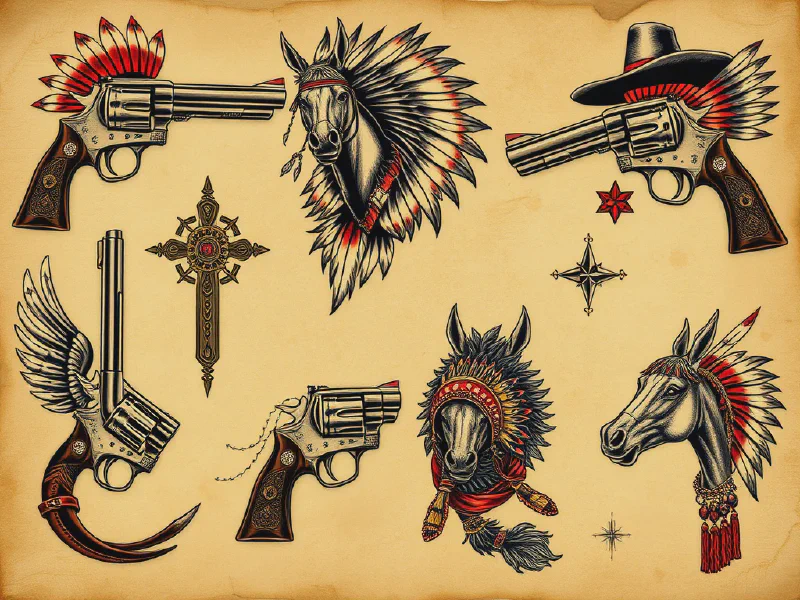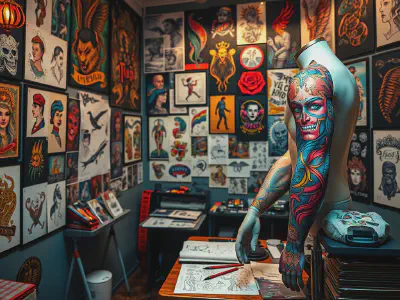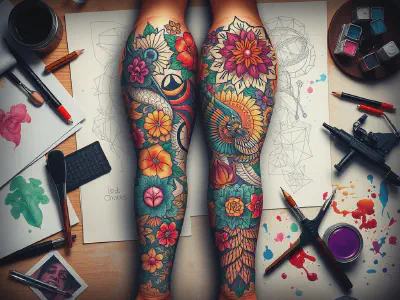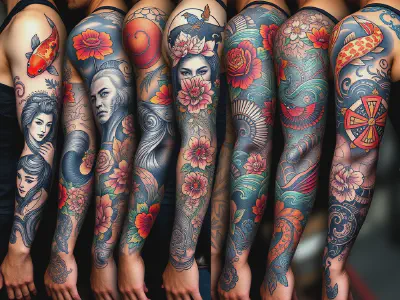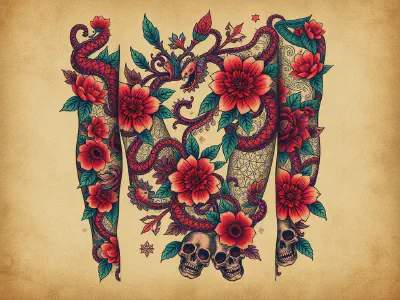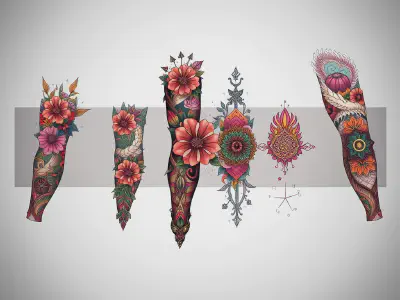How to Build a Tattoo Sleeve: A Comprehensive Guide
Building a tattoo sleeve is a complex and personal process. It requires careful consideration of various factors, such as choosing a theme, designing the sleeve, selecting placement, scheduling sessions, preparing for sessions, and caring for the tattoo. In this comprehensive guide, we will walk you through each step of the journey to help you build your dream tattoo sleeve.
Have you always been fascinated by the art of tattoos and wondered how to build a tattoo sleeve ? Rest assured, you are not alone! Starting any tattoo journey can be daunting, especially if it involves a sleeve. A great resource to consider is the post created by Remington Tattoo Parlor, outlining the steps to plan a killer tattoo sleeve . There, you'll find a wealth of information that can take you step by step through the process of developing a spectacular tattoo sleeve design.
Choosing a Theme
For anyone focusing on how to construct a striking tattoo sleeve , melding artistry with personal meaning, it's well worth checking out the insightful Remington Tattoo Parlor . This is an excellent space where you can learn more about the topics of tattooing and sleeve building, get inspired by their body artworks, and engage in discussions with tattoo enthusiasts and like-minded individuals.
The first step in building a tattoo sleeve is choosing a theme that resonates with you. There are several popular themes to consider:
Traditional Tattoos: These tattoos are inspired by classic American tattooing. They often feature bold lines, bright colors, and iconic imagery such as anchors, roses, and skulls.
Black and Grey Tattoos: This style uses shades of black and grey to create intricate and realistic designs. It is a versatile option that can be used for various themes, from portraits to nature scenes.
Choosing a Theme
Traditional Tattoos: These tattoos are inspired by classic American tattooing. They often feature bold lines, bright colors, and iconic imagery such as anchors, roses, and skulls.
Black and Grey Tattoos: This style uses shades of black and grey to create intricate and realistic designs. It is a versatile option that can be used for various themes, from portraits to nature scenes.
Japanese Tattoos: These tattoos are influenced by traditional Japanese art, such as ukiyo-e woodblock prints and irezumi-style tattoos. They often feature mythical creatures, cherry blossoms, and koi fish.
Colorful Tattoos: This style incorporates vibrant colors and bold designs. It is perfect for those who want to make a statement and showcase their personality through their tattoos.
Abstract Tattoos: This style focuses on unique shapes, lines, and patterns. It allows for creative expression and can be interpreted in various ways.
Designing the Sleeve
Once you have chosen a theme, the next step is to design the sleeve. This involves several steps:
Are you eager to understand how to put together a significant tattoo sleeve seamlessly? One of the best places to go for priceless tips and inspirations is Remington Tattoo Parlor on Yelp . Customers have praised their artistic abilities and shared stunning photos of completed works, which could possibly ignite your imagination and provide you with a clearer vision of what you want on your future tattoo sleeve.
Researching Artists: Look for tattoo artists who specialize in the style you have chosen. Browse their portfolio to ensure their work aligns with your vision.
Building a tattoo sleeve is an art—it's a combination of correct planning, choosing the right artist, and adding elements that personalize your artwork. If you're in the process of planning how to piece together a beautiful tattoo sleeve , we suggest browsing online resources including professional tattoo parlors like Remington Tattoo , which offers a detailed guide into planning your dream tattoo sleeve.
Collaborating with an Artist: Schedule a consultation with the chosen artist to discuss your ideas and collaborate on the design. Remember to communicate your preferences clearly and provide any reference materials you may have.
Customizing Designs: Work with the artist to customize the designs to fit your body and preferences. They will create a unique and personalized design that suits your vision.
Incorporating Personal Meaning: Consider adding elements with personal meaning to the design. This could be symbols, quotes, or images that hold significance to you.
Selecting Placement
Choosing the right placement for your sleeve is crucial. Consider the following options:
Full Sleeve: This option covers the entire arm, from shoulder to wrist. It allows for a larger and more interconnected design.
Half Sleeve: This option covers either the upper or lower half of the arm. It provides a balanced look and is often more manageable for those who prefer smaller designs.
Quarter Sleeve: This option covers a quarter of the arm, either the top or bottom portion. It is a good choice for those who want a smaller, more discreet tattoo.
Inner Arm: This placement is on the inside of the arm and can be seen when the arm is bent. It is a popular choice for meaningful quotes or personal messages.
Scheduling Sessions
Building a tattoo sleeve is a time-consuming process that requires multiple sessions. Consider the following factors when scheduling sessions:
Session Duration: Take into account the duration of each session when planning your schedule. Longer sessions may be more tiring, so it's important to pace yourself.
Spacing Sessions: Allow enough time between sessions for your tattoo to heal properly. This will vary depending on your body's healing rate and the artist's recommendations.
The journey on how to design a captivating tattoo sleeve calls for detailed research and understanding of the art. You can delve into the unique and beautifully created tattoos shared on the website of professional parlors like Remington Tattoo Parlor . By browsing through their gallery, you can pick up on trending designs and get inspired while planning out your own tattoo sleeve.
Allowing for Healing Time: After each session, your tattoo will need time to heal. Avoid scheduling sessions too close together to ensure proper healing.
Remember, building a tattoo sleeve is not just about adding tattoos to your arm—every tattoo holds a story of its own. Start weaving your narrative today!
Booking Appointments: Coordinate with your chosen artist to book sessions in advance. Their availability may depend on their schedule and workload.
Preparing for Sessions
Before each session, it's important to prepare both physically and mentally. Consider the following steps:
Choosing the Right Clothing: Wear loose, comfortable clothing that allows easy access to the tattooed area. This will ensure a more comfortable session for both you and the artist.
Properly Hydrating the Skin: Keep your skin hydrated by moisturizing regularly leading up to the session. This will help the tattoo application process and aid in healing.
Avoiding Alcohol and Blood Thinners: A few days before your session, avoid consuming alcohol and blood thinners, as they can increase bleeding during the tattooing process.
Eating a Good Meal Beforehand: Ensure you have a good meal before each session to maintain your energy levels and prevent lightheadedness during the tattooing process.
Caring for the Tattoo
After your tattoo sleeve is complete, proper aftercare is essential to ensure its longevity and vibrancy. Follow these guidelines:
Following Aftercare Instructions: Listen to the aftercare instructions provided by your artist. This will typically include gentle cleaning and applying a recommended aftercare product.
Gentle Cleaning and Moisturizing: Clean your tattoo gently with a mild, fragrance-free soap and lukewarm water. Pat it dry and apply a thin layer of aftercare lotion to keep it moisturized.
Avoiding Sun Exposure: Protect your tattoo from direct sunlight, as UV rays can fade the colors and cause damage to the skin. Use sunscreen or cover the tattooed area when exposed to the sun.
Touch-ups and Maintenance: Over time, tattoos may require touch-ups to maintain their appearance. Stay in touch with your artist for any necessary touch-ups and follow-up maintenance.
